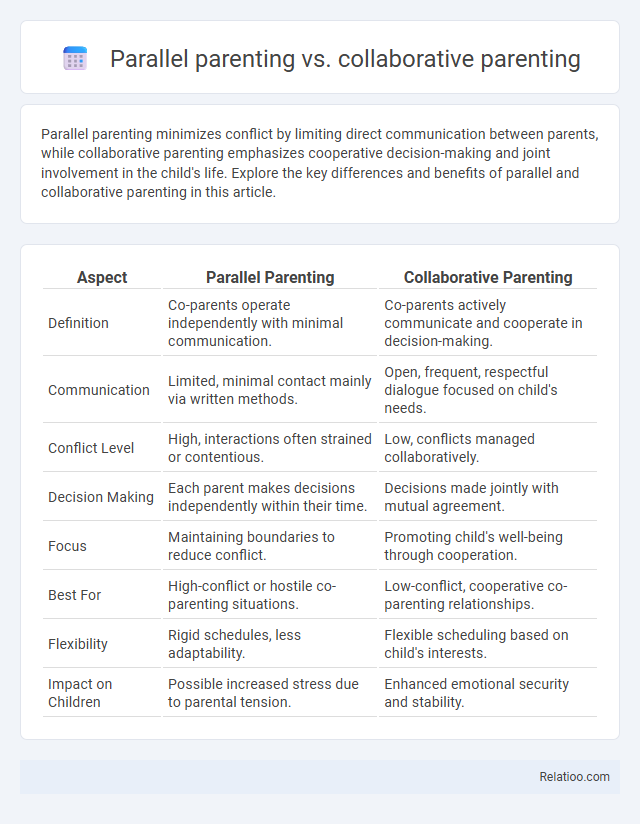Parallel parenting minimizes conflict by limiting direct communication between parents, while collaborative parenting emphasizes cooperative decision-making and joint involvement in the child's life. Explore the key differences and benefits of parallel and collaborative parenting in this article.
Table of Comparison
| Aspect | Parallel Parenting | Collaborative Parenting |
|---|---|---|
| Definition | Co-parents operate independently with minimal communication. | Co-parents actively communicate and cooperate in decision-making. |
| Communication | Limited, minimal contact mainly via written methods. | Open, frequent, respectful dialogue focused on child's needs. |
| Conflict Level | High, interactions often strained or contentious. | Low, conflicts managed collaboratively. |
| Decision Making | Each parent makes decisions independently within their time. | Decisions made jointly with mutual agreement. |
| Focus | Maintaining boundaries to reduce conflict. | Promoting child's well-being through cooperation. |
| Best For | High-conflict or hostile co-parenting situations. | Low-conflict, cooperative co-parenting relationships. |
| Flexibility | Rigid schedules, less adaptability. | Flexible scheduling based on child's interests. |
| Impact on Children | Possible increased stress due to parental tension. | Enhanced emotional security and stability. |
Understanding Parallel Parenting and Collaborative Parenting
Parallel parenting separates parents to minimize conflict by limiting direct communication and interaction, focusing on individual responsibility for the child's needs. Collaborative parenting emphasizes cooperative communication and joint decision-making to support the child's well-being and maintain a unified parenting approach. Understanding these distinct approaches helps you choose the most effective strategy for managing co-parenting dynamics and promoting stability for your child.
Key Differences Between Parallel and Collaborative Parenting
Parallel parenting involves minimal direct communication between parents, focusing on separate decision-making and reducing conflict, while collaborative parenting requires ongoing cooperation, shared decision-making, and active communication to jointly address parenting responsibilities. The key difference lies in the level of interaction and coordination; parallel parenting suits high-conflict situations where cooperation is difficult, whereas collaborative parenting thrives on mutual agreement and teamwork for your child's well-being. Understanding these distinctions helps you choose the best approach based on parental dynamics and your child's needs.
Benefits of Parallel Parenting
Parallel parenting minimizes conflict by allowing parents to operate independently while focusing on the child's well-being, reducing direct interaction and potential disputes. Your child benefits from a stable environment as each parent maintains consistent rules and routines in separate households, promoting emotional security. This approach is especially effective in high-conflict situations, enabling parents to prioritize the child's needs without constant negotiation or confrontation.
Benefits of Collaborative Parenting
Collaborative parenting fosters effective communication and joint decision-making, leading to a more stable and consistent environment for children. This approach reduces conflict and promotes emotional well-being by encouraging mutual respect and shared responsibilities between parents. Collaborative parenting often results in improved co-parenting relationships and better long-term outcomes for children's development and adjustment.
Challenges of Parallel Parenting
Parallel parenting often leads to communication breakdown and increased conflict between parents due to minimal interaction and strict boundaries. Unlike collaborative parenting, which emphasizes cooperation and shared decision-making, parallel parenting focuses on minimizing contact, making it difficult to resolve disputes or coordinate child-rearing strategies effectively. These challenges can result in inconsistent parenting styles and emotional stress for children caught between conflicting parental approaches.
Challenges of Collaborative Parenting
Collaborative parenting requires effective communication and mutual respect but often faces challenges such as conflicting parenting styles, unresolved emotional tensions, and inconsistent decision-making. Unlike parallel parenting, which minimizes direct interaction to reduce conflict, collaborative parenting demands ongoing cooperation that can be difficult after separation. Your ability to maintain open dialogue and prioritize your child's well-being is critical to overcoming these obstacles and achieving a balanced approach.
When to Choose Parallel Parenting
Parallel parenting is best suited when high conflict exists between parents, making direct communication difficult or harmful to Your child's well-being. Collaborative parenting works well when both parents can communicate effectively and prioritize co-parenting decisions collectively. Choosing parallel parenting ensures minimal interaction, reducing tension while maintaining separate responsibilities for Your child's care.
When Collaborative Parenting Works Best
Collaborative parenting works best when both parents maintain open communication, mutual respect, and a shared commitment to their children's well-being despite personal differences. This approach fosters joint decision-making and cooperative problem-solving, benefiting children's emotional stability and development. In contrast, parallel parenting is effective when high conflict or limited trust makes direct interaction difficult, as it minimizes communication and interaction between parents.
Tips for Transitioning Between Parenting Styles
Transitioning between parallel, collaborative, and co-parenting requires clear communication and adaptability to the changing needs of the child and parents. Establishing consistent routines and setting mutual boundaries help minimize conflicts while fostering a cooperative environment. Prioritize the child's well-being by gradually increasing joint decision-making and maintaining respect for each other's parenting role.
The Impact of Parenting Styles on Children
Parallel parenting minimizes direct interaction between high-conflict parents, reducing child exposure to parental disputes but potentially creating inconsistent discipline. Collaborative parenting emphasizes cooperation and communication, fostering a stable environment that supports emotional security and development in children. Contrasting these, joint parenting involves shared decision-making with active engagement, promoting balanced nurture and social skills growth while requiring low parental conflict levels.

Infographic: Parallel parenting vs Collaborative parenting
 relatioo.com
relatioo.com